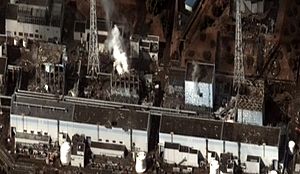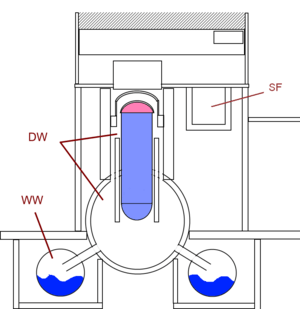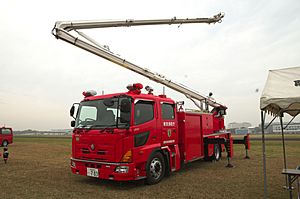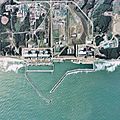Fukushima Daiichi Nuclear Power Plant facts for kids
Fukushima Daiichi Nuclear Power Plant (also called Fukushima I) is a disabled nuclear power plant in the town of Ōkuma in Fukushima Prefecture, Japan. Fukushima Daiichi was the first nuclear power plant to be built and run only by the Tokyo Electric Power Company (TEPCO).
In March 2011 there were nuclear emergencies at the power plant and some other Japanese nuclear facilities, which raised questions about the future of nuclear power. Following the Fukushima nuclear disaster, the International Energy Agency halved its estimate of additional nuclear generating capacity to be built by 2035.
Contents
The nuclear reactors
The nuclear reactors for units 1, 2, and 6 were supplied by General Electric, those for units 3 and 5 by Toshiba, and unit 4 by Hitachi. The architectural design for the General Electric's units was done by Ebasco. All of the building work was done by Kajima. Since September 2010, unit 3 has been fueled by MOX fuel|mixed-oxide (MOX) fuel. Units 1–5 had/have a Mark 1 type (light bulb shaped torus) containment structure, unit 6 has Mark 2 type (over/under) containment structure.
Unit 1 is a 439 MW boiling water reactor (BWR3) constructed in July 1967. It started to commercially make electricity on March 26, 1971, and was planned to shutdown in March, 2011. It was damaged during the 2011 Sendai earthquake and tsunami. The reactor had high atomic and earthquake safety levels when it was made, but it is now both old and out of date. No one knew such a bad earthquake could happen in Japan. Unit 1 was designed for a earthquake peak ground acceleration shaking motion of 0.18 g (1.74 m/s2) and a seismic response spectrum based on the 1952 Kern County earthquake. All units were inspected after the 1978 Miyagi earthquake when the seismic ground acceleration was 0.125 g (1.22 m/s2) for 30 seconds, but no damage to the critical parts of the reactor was discovered.
| Unit | Type | First went atomically 'critical' | Electric power generated | Reactor supplied by | Designed by | Built by |
|---|---|---|---|---|---|---|
| Fukushima I – 1 | BWR-3 | October 1970 | 460 MW | General Electric | Ebasco | Kajima |
| Fukushima I – 2 | BWR-4 | July 18, 1974 | 784 MW | General Electric | Ebasco | Kajima |
| Fukushima I – 3 | BWR-4 | March 27, 1976 | 784 MW | Toshiba | Toshiba | Kajima |
| Fukushima I – 4 | BWR-4 | October 12, 1978 | 784 MW | Hitachi | Hitachi | Kajima |
| Fukushima I – 5 | BWR-4 | April 18, 1978 | 784 MW | Toshiba | Toshiba | Kajima |
| Fukushima I – 6 | BWR-5 | October 24, 1979 | 1,100 MW | General Electric | Ebasco | Kajima |
| Fukushima I – 7 (planned) | ABWR | October 2016 | 1,380 MW | |||
| Fukushima I – 8 (planned) | ABWR | October 2017 | 1,380 MW |
2011 Fukushima nuclear disaster
In March 2011, soon after the Sendai earthquake and tsunami, the Japanese government cleared people from around the plant and started local emergency laws at Fukushima I. Ryohei Shiomi of Japan's nuclear safety board was worried about the chance of a meltdown at Unit 1. The next day, the Chief Cabinet Secretary, Yukio Edano said that a partial meltdown at Unit 3 was "highly possible."
The Nuclear Engineering International group had reported that Units 1, 2 and 3 were automatically shut down. Units 4, 5 and 6 had already been shut down for maintenance. Back-up generators were damaged by the tsunami; started at first, but stopped after 1 hour later.
Japan’s government said it had and a nuclear emergency when the cooling problems happened as the back-up diesel generators broke down. The cooling is needed to remove decay heat even when a plant has been shut down, due to the long term atomic reactions. Hundreds of Japanese troops were said to be trucking generators and batteries to the site.
Reactor and generators damage reports (09.53 UTC, 16-3-2011)
After the back-up diesel generators pumps broke down, emergency batteries ran low after about eight hours. Batteries from other nuclear plants were sent to the site and mobile electric and diesel generators arrived within 13 hours, but work to connect portable generating equipment to power water pumps was still continuing as of 15:04 on 12 March. The diesel generators would normally be connected by switching gears in a basement area of the power station's buildings, but this had been flooded by the tsunami.
Data estimated by JAIF (Japan Atomic Industrial Forum).
| Status of reactors at 22:00 March 21 JST | 1 | 2 | 3 | 4 | 5 | 6 |
|---|---|---|---|---|---|---|
| Electrical power output (MWe) | 460 | 784 | 784 | 784 | 784 | 1100 |
| Type of reactor | BWR-3 | BWR-4 | BWR-4 | BWR-4 | BWR-4 | BWR-5 |
| Operating status at earthquake | In service | In service | In service | Outage (defueled) | Outage (scheduled) | Outage (scheduled) |
| Fuel damage level | 70% damaged | 33% damaged | Damaged | Not damaged | Not damaged | Not damaged |
| Primary containment damage level | Not damaged | Damage suspected | Might be "Not damaged" | Not damaged | Not damaged | Not damaged |
| Core cooling system 1 (ECCS/RHR) | Not functional | Not functional | Not functional | Not necessary | Not necessary, AC power available | Not necessary, AC power available |
| Core cooling system 2 (RCIC/MUWC) | Not functional | Not functional | Not functional | Not necessary | Not necessary | Not necessary |
| Building damage level (secondary containment) | Severely damaged by explosion | Slightly damaged by explosion | Severely damaged by explosion | Severely damaged by explosion | Vent holes drilled in roof | Vent holes drilled in roof |
| Environmental effect (measured north of Service Building) | 2019 µSv/hour at 15:00, March 21 | |||||
| Pressure vessel, water level | Fuel exposed partially or fully | Fuel exposed partially or fully | Fuel exposed partially or fully | Safe | Safe and in cold shutdown | Safe and in cold shutdown |
| Pressure vessel, pressure | Stable | Unknown | Unknown | Safe | Safe | Safe |
| Containment unit pressure | Stable | Stable | Decreasing | Safe | Safe | Safe |
| Was seawater injected into reactor core | Continuing | Continuing | Continuing | Not necessary | Not necessary | Not necessary |
| Was seawater injected into primary containment vessel | Continuing | To be decided | Continuing | Not necessary | Not necessary | Not necessary |
| Containment unit venting | Yes, but temporarily stopped | Yes, but temporarily stopped | Yes, but temporarily stopped | Not necessary | Not necessary | Not necessary |
| Spent fuel damage level | Unknown, water injection is being considered | Unknown, seawater injection was performed on March 20 | SFP water level low Seawater spray continues, Damage to fuel rods suspected |
SFP water level low Seawater spray continues, Damage to fuel rods suspected |
SFP cooling capacity has been recovered | SFP cooling capacity has been recovered |
| Evacuation zone's radius | 20 km from NPS | |||||
| INES | Level 5 (estimated by Japanese NISA and accepted by the international IAEA); Level 6 (estimated by the French nuclear authority and the Finnish nuclear authorities); de facto Level 5 (containment of reactor core has been breached) | |||||
Later, unit 4 at the nearby Fukushima II Nuclear Power Station was also shut down by the safety systems. Now, a source of off-site power is available but the damage level at the plant is bad.
Proposed long term safety activity
Boron
Officials have thought about putting in or aerial dropping radiation killing boric acid, boronated plastic beads or boron carbide pellets into the spent fuel pools to absorb neutrons. France flew 95 tonnes of boron to Japan on 17 March 2011. Neutron are absorbed by boric acid, which has been injected into the reactor cores, but is unclear if boron was also included with the hose and fire truck water spraying of SFPs.
A 'Sarcophagus tomb' and liquid metal
On 18 March, the Reuters news agency reported that Hidehiko Nishiyama, a spokesman of Japan's nuclear agency was asked about burying the reactors in a sand and concrete tomb, said: "That solution is in the back of our minds, but we are focused on cooling the reactors down."
After the Chernobyl disaster, the atomic safety workmen used 1,800 metric tonnes of sand and clay cover the plant. This created a problem because they were thermal insulators and trapped heat inside. So first a non-evaporating coolant such as a liquid metal has to be put on it. After it has all cooled off a structure such as the Chernobyl Nuclear Power Plant 'sarcophagus tomb'.
Implications
The nuclear emergencies at Fukushima Daiichi and other nuclear facilities raised questions about the future of nuclear power. Platts has said that "the crisis at Japan's Fukushima nuclear plants has prompted leading energy-consuming countries to review the safety of their existing reactors and cast doubt on the speed and scale of planned expansions around the world". Following the Fukushima nuclear disaster, the International Energy Agency halved its estimate of additional nuclear generating capacity to be built by 2035.
Media
Images for kids
-
Three of the reactors at Fukushima Daiichi overheated, causing meltdowns that eventually led to explosions, which released large amounts of radioactive material into the air.
-
Prime Minister Yoshihide Suga inspected the Daiichi Nuclear Power Plant on September 26, 2020
See also
 In Spanish: Central nuclear Fukushima I para niños
In Spanish: Central nuclear Fukushima I para niños













